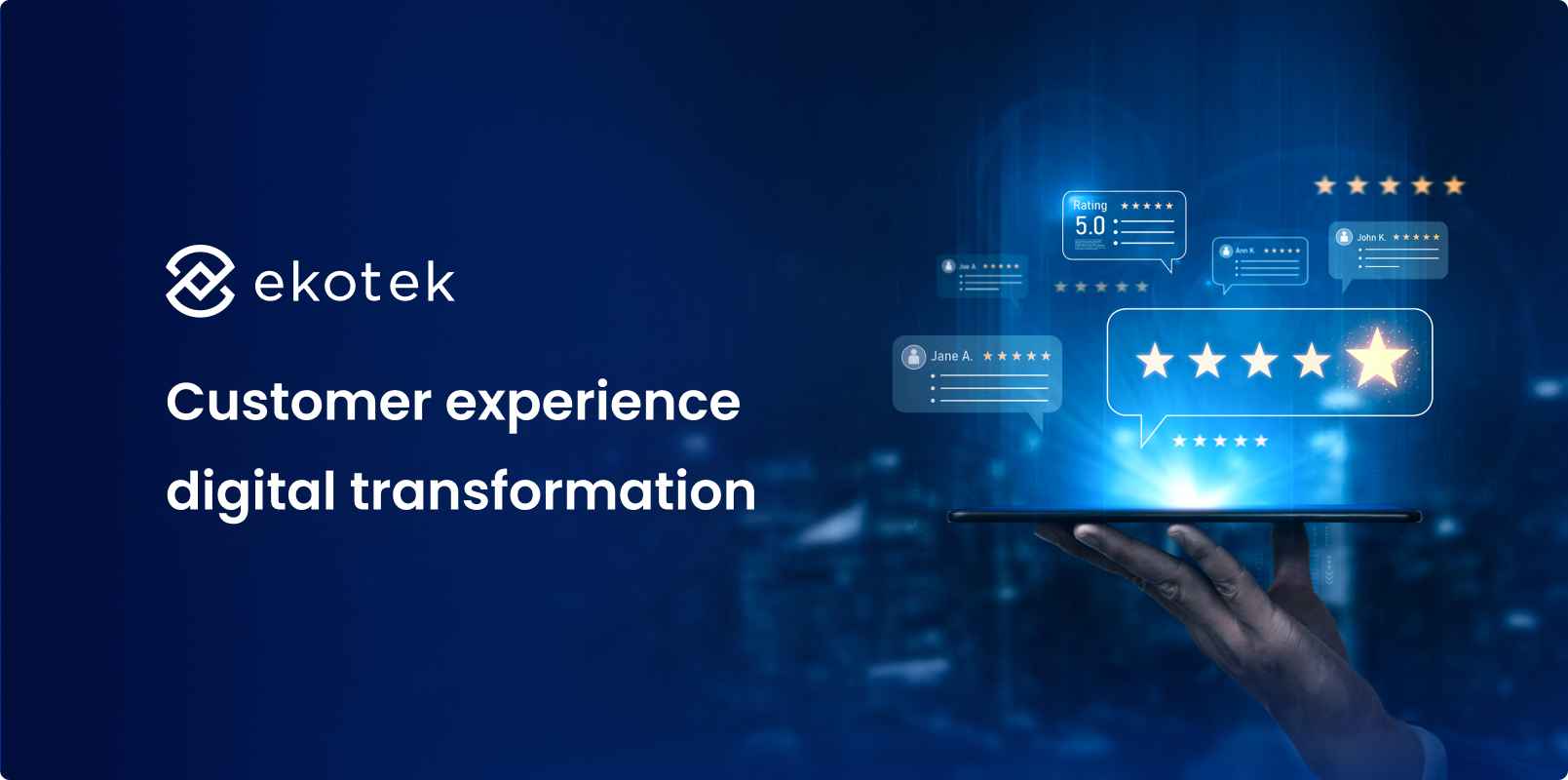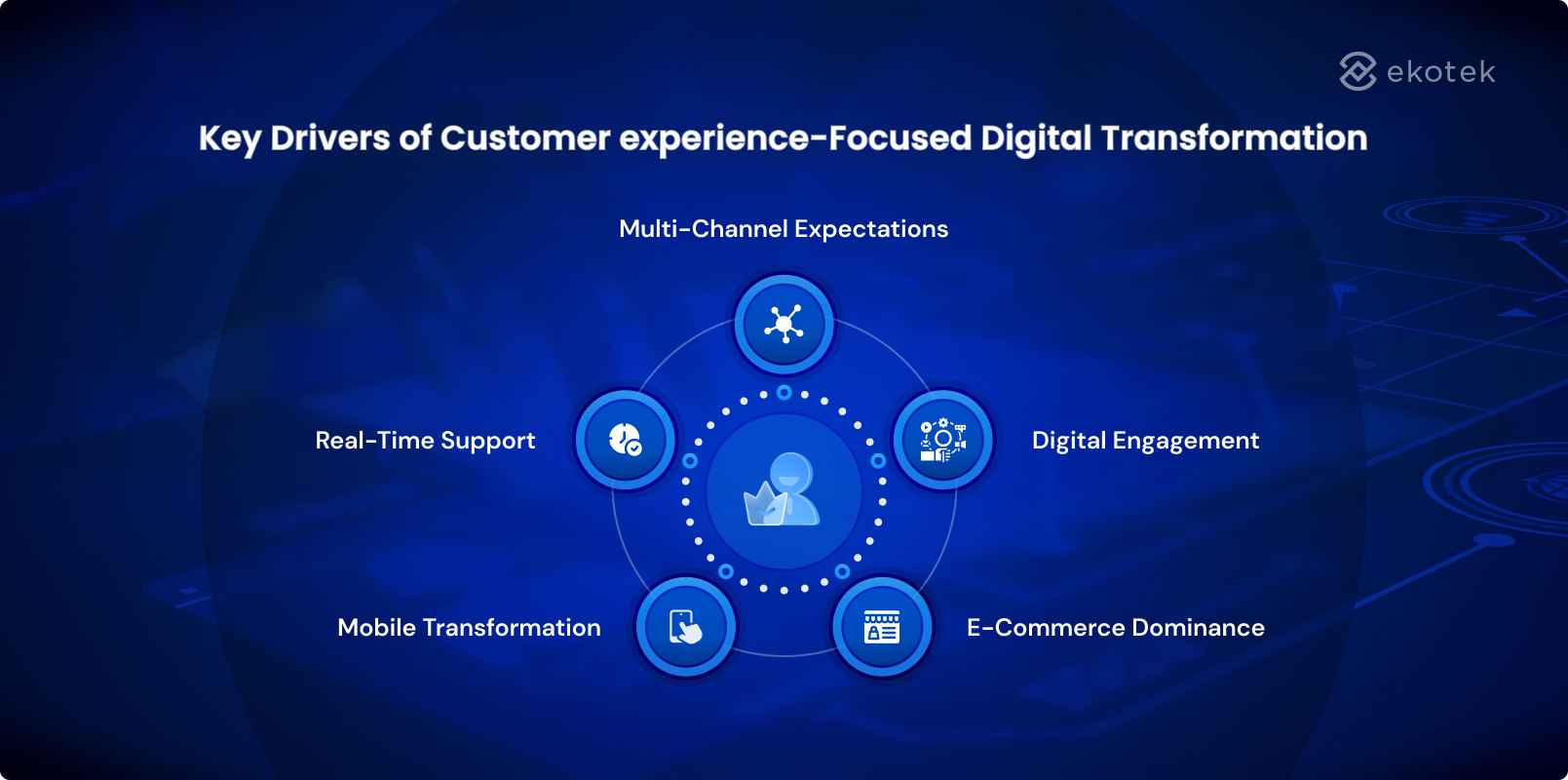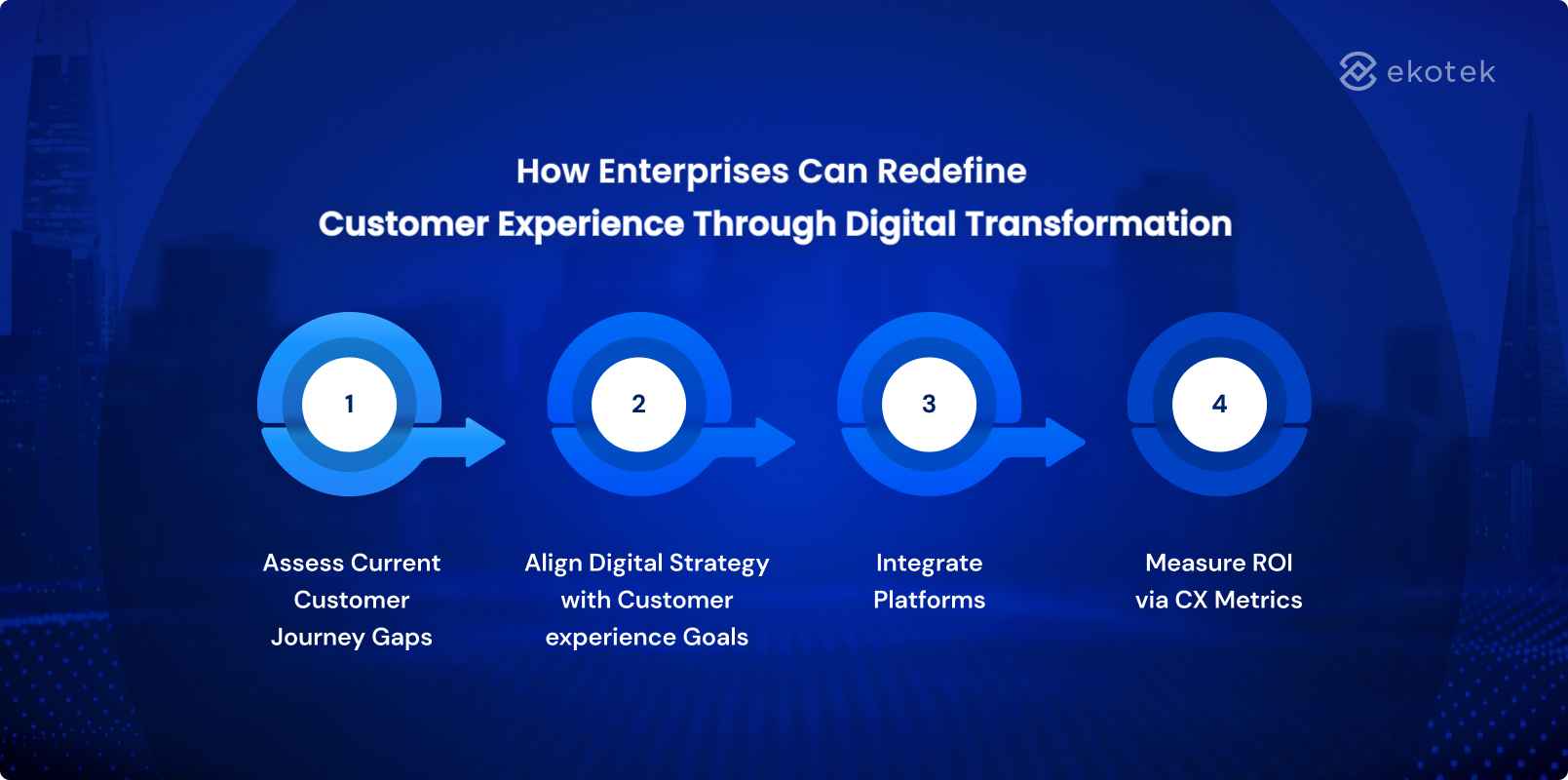
- 1
- 2
- 3
- 4
- 5
- 6
- 7
Introduction
In today’s hyper-competitive landscape, the way companies treat their customers is no longer just a soft differentiator, it’s a core driver of growth, retention, and long-term relevance. Businesses embracing customer experience digital transformation are not only meeting rising expectations, but also gaining the agility, insights, and operational excellence to outperform their peers. But what exactly does transforming customer experience mean in the digital age? Why is it crucial for organizations of all sizes? And most importantly, how can leaders follow a practical, results-focused roadmap to success?
In this guide, you’ll discover the driving forces behind customer experience transformation and the main technologies enabling this change, actionable strategies, real-world case studies. Whether you’re just beginning your digital transformation journey or looking to accelerate ROI across customer experience, this resource outlines what to expect, and how you can lead your organization toward sustained success.
The Evolving Role of Customer Experience in the Digital Era
Customer experience (CX) is no longer just about solving problems, it’s about creating value at every digital touchpoint. As digital transformation accelerates, CX has become a core business strategy rather than a supporting function.
From Support to Strategy
In the past, customer experience focused on after-sales service or issue resolution. Today, it drives brand perception, loyalty, and growth. Every online interaction, from website navigation to chat support, shapes how customers feel about a brand.
Rising Expectations in the Digital Age
Modern customers expect:
-
Instant responses through chatbots and automation
-
Personalized experiences based on their behavior and preferences
-
Seamless journeys across mobile, web, and in-store channels
Failing to meet these expectations means losing trust and competitiveness.
Data-Driven, Human-Centered CX
Through customer experience digital transformation, businesses now use data analytics, AI, and automation to:
-
Understand customer needs in real time
-
Predict future behavior
-
Deliver more personalized engagement
But technology alone isn’t enough. True CX excellence combines digital tools with empathy, ensuring every interaction feels human, not robotic
Key Drivers of Customer experience-Focused Digital Transformation
 A customer experience-focused digital transformation is powered by new behaviors, technologies, and expectations. Today’s customers want fast, seamless, and meaningful interactions, anytime, anywhere. Below are the key forces shaping this shift.
A customer experience-focused digital transformation is powered by new behaviors, technologies, and expectations. Today’s customers want fast, seamless, and meaningful interactions, anytime, anywhere. Below are the key forces shaping this shift.
Multi-Channel Expectations
Customers no longer follow a single path to purchase. They move fluidly between websites, mobile apps, social media, and in-store experiences.
Organisations with strong multichannel strategies see about 25% higher retention and somewhat higher revenue (e.g., a ~9.5% increase) compared to single-channel peers
To stay competitive, businesses must offer a consistent brand experience across all touchpoints, where every channel feels connected and familiar.
Digital Engagement
Customers expect brands to be present and responsive in the digital spaces they use daily. This means using social media, chatbots, email, and community platforms to deliver real-time value, not just marketing messages.
Strong digital engagement builds trust and keeps customers coming back.
E-Commerce Dominance
The rise of e-commerce has redefined how people buy, compare, and interact with brands. Convenience, speed, and transparency are now the standard.
Mobile commerce (mCommerce) is surging: 43% of global e-commerce sales were projected to be mobile by 2024, and some estimates put mCommerce at 73% of all e-commerce by 2025
Companies that integrate personalized recommendations, easy checkouts, and clear communication into their digital journeys gain a powerful CX advantage.
⭐️ You may be interested in Digital Transformation In Retail
Mobile Transformation
The smartphone is now the primary customer touchpoint. From discovery to post-purchase support, mobile experiences must be fast, intuitive, and personalized.
Optimizing mobile CX, through responsive design, app usability, and mobile payments, directly impacts customer satisfaction and retention.
⭐️ Dive into Enterprise mobile app development
Real-Time Support
Modern customers don’t want to wait. They expect immediate solutions, whether through AI-powered chatbots, live chat, or self-service portals.
Providing real-time assistance shows customers that your brand values their time, a crucial part of digital CX excellence.
How Enterprises Can Redefine Customer Experience Through Digital Transformation
 Step 1: Assess Current Customer Journey Gaps
Step 1: Assess Current Customer Journey Gaps
Before improving CX, you need to understand where it’s breaking down. Start by mapping the customer journey, from awareness to post-purchase, and identifying:
-
Friction points in navigation, service, or communication
-
Slow response times or inconsistent brand messaging
-
Missing personalization opportunities
Use customer feedback, analytics, and social listening to reveal where expectations aren’t being met.
This assessment becomes the foundation for your digital transformation roadmap.
Step 2: Align Digital Strategy with Customer experience Goals
Digital transformation should start with customer needs, not technology. Ask:
-
What experience do we want customers to have?
-
How can technology make that journey smoother, faster, or more personal?
Align every initiative, whether automation, AI, or new platforms, with specific customer experience outcomes, such as:
-
Shorter resolution times
-
Higher engagement and satisfaction
-
Increased loyalty and referrals
When your digital strategy reflects customer experience priorities, transformation becomes truly customer-driven.
Step 3: Integrate Platforms (CRM, Analytics, Automation)
A seamless CX depends on connected data and systems. Break down silos by integrating key tools:
-
CRM for unified customer profiles and history
-
Analytics platforms for insights into behavior and trends
-
Automation tools for consistent, efficient communication
When these platforms work together, teams can deliver personalized, proactive experiences that feel effortless to the customer.
Consider Outsourcing for Expertise and Acceleration
Many enterprises choose to partner with digital transformation service providers to accelerate implementation. These partners bring specialized expertise, proven frameworks, and cross-industry experience, helping companies:
-
Identify the right technology stack for their CX goals
-
Avoid costly integration mistakes
-
Develop scalable, future-ready digital ecosystems
By outsourcing to experienced providers, organizations can gain both speed and strategic insight, ensuring that their customer experience transformation is executed efficiently and aligned with best practices.
Step 4: Measure ROI via CX Metrics (NPS, Retention, Conversion)
Transformation success must be quantifiable. Track progress with CX-focused KPIs, such as:
-
Net Promoter Score (NPS): to measure customer advocacy
-
Customer Retention Rate: to gauge loyalty
-
Conversion Rate: to evaluate how well digital experiences drive action
-
Customer Effort Score (CES): to see how easy interactions have become
Regularly monitor these metrics to understand what’s working, and where to improve. Data-driven evaluation ensures CX transformation delivers real business impact.
⭐️ Check out how top companies gain benefits with Digital transformation case studies
Common Challenges and How to Overcome Them
Lack of Unified Vision Across Departments
The challenge: Many teams still operate in silos, marketing, sales, and customer service each focusing on their own KPIs. This fragmentation leads to inconsistent experiences and duplicated efforts.
How to overcome it:
-
Establish a cross-functional CX task force that aligns goals across departments.
-
Appoint a Chief Experience Officer (CXO) or transformation leader to drive a unified vision.
-
Communicate clear CX objectives that everyone understands, from frontline staff to executives.
Resistance to Change
The challenge: Employees may feel threatened by automation or unfamiliar technologies. Cultural inertia is often one of the biggest barriers to digital transformation.
How to overcome it:
-
Promote a change-ready culture through training, communication, and involvement.
-
Celebrate small wins to build confidence and momentum.
-
Emphasize how digital tools empower people, not replace them, helping employees deliver better experiences faster.
⭐️ Learn more about Digital workplace transformation
Technology Overload and Poor Integration
The challenge: Implementing too many disconnected tools can create data chaos instead of clarity. Without integration, it’s impossible to get a 360° view of the customer.
How to overcome it:
-
Focus on platform interoperability, integrate CRM, analytics, and automation tools into one ecosystem.
-
Partner with experienced digital transformation service providers who can guide tech selection and system integration.
-
Start small, scale gradually, prioritize technologies that directly improve CX outcomes.
⭐️ Read our guide about AI integration
Insufficient Data Utilization
The challenge: Organizations collect large volumes of customer data but fail to translate it into actionable insights. As a result, personalization remains superficial.
How to overcome it:
-
Use AI and advanced analytics to turn raw data into predictive insights.
-
Encourage a data-driven mindset within all teams.
-
Set up real-time dashboards to measure key CX metrics (NPS, CES, retention, conversion).
Ekotek Real-World Examples of Customer experience-Led Transformation
Integrating eKYC & Mobile-First Onboarding
Ekotek partnered with a high-end global property investment platform to modernize its onboarding and identity verification process, going from bulky offline postal forms to a fully digital eKYC system developed in just 10 weeks.
Why it matters for CX:
-
Users can now fill in information and upload documents within minutes, instead of dealing with paper and shipping.
-
The streamlined process enhances user satisfaction, boosts conversion, and reinforces trust.
🔑 See how we revolutionized eKYC onboarding for a global platform
F&B: An NFT-Powered Loyalty Experience
A global food & beverage leader sought to elevate customer engagement and loyalty. Ekotek created a blockchain-based NFT marketplace in just 3 months to merge physical products with exclusive digital collectibles.
Why it matters for CX:
-
The brand reached a younger, tech-savvy audience by offering digital assets tied to real-world experiences.
-
This shaped a new kind of loyalty model, less about points, more about ownership and connection.
🔑 Discover how Web3 is transforming loyalty programs
AI-Driven, Real-Time Customer Support
For an e-commerce/NFT platform, Ekotek built an intelligent AI chatbot integrated with ChatGPT, deploying it in just 2 weeks to handle 24/7 customer queries.
Why it matters for CX:
-
The chatbot uses natural language processing and contextual learning to provide accurate, human-like support responses.
-
This reduces response times, improves customer satisfaction, and scales support without equivalent staffing cost.
🔑 Learn how AI-powered chatbots can enhance your customer support
Conclusion
Digital transformation is reshaping every aspect of customer experience, creating new opportunities and demanding greater agility from organizations. Leaders committed to a strategic, technology-enabled, and customer-centric approach will unlock value that outpaces the competition, retains loyal clients, and inspires teams to innovate continuously. The journey is complex, but with the right vision, partners, and action plan, CX transformation will propel your organization to sustainable success.
Ekotek stands out as a trusted partner in this journey of customer experience digital transformation. Specializing in software development and digital solutions across industries like manufacturing, retail, and banking, we provide comprehensive consulting, DX product development, and ongoing support. Our expertise in advanced technologies such as AI and blockchain, ensures seamless integration into your operations.
With a proven track record and a tailored approach to every client’s needs, Ekotek helps businesses navigate the complexities of digital transformation. Whether you’re looking to optimize customer engagement, modernize operations, or drive innovation, Ekotek is committed to delivering measurable success and transforming your digital experience.
FAQ on Customer experience digital transformation
1. Why is customer experience important in digital transformation?
Customer experience is central to digital transformation because it directly impacts customer loyalty, retention, and brand perception. By leveraging digital technologies, businesses can deliver personalized, seamless experiences that meet modern customer expectations, driving long-term growth.
2. How can my company start a digital transformation for customer experience improvement?
Begin by assessing your current customer journey to identify gaps. Align your digital strategy with CX goals, integrate the right platforms (CRM, analytics, automation), and measure success using CX metrics like NPS and retention. Partnering with an experienced provider can accelerate the process.
3. What technologies are most effective for improving customer experience?
Key technologies that drive customer experience improvement include AI for personalized support, blockchain for secure loyalty programs, and automation for faster, more efficient service. These tools enable businesses to respond faster and more accurately, enhancing customer satisfaction.
4. How do I measure the success of my customer experience digital transformation?
Measure success using KPIs like Net Promoter Score (NPS), customer retention, and conversion rates. By regularly tracking these metrics, businesses can understand the impact of their CX efforts and continuously optimize the customer journey for better results.
- 1
- 2
- 3
- 4
- 5
- 6
- 7